Last updated on April 1, 2024

Megatron, Tyrant | Illustration by Volta Creation
With the coming of The Brothers’ War we return to the beginning of Magic’s history. Wizards is specifically revisiting the first three expansions (Antiquities, The Dark, and Fallen Empires) with a modern twist, both mechanically and literally given the storyline at play here.
But beyond the reprints that are getting a lot of love and the art style, we’re also being introduced to some of the Universes Beyond cards that continue to come to the market, this time being distributed in a mainline set.
Transformers pairs Magic mechanics with another Hasbro-owned franchise. While the cards themselves work similar to other double-sided cards, they also come with their own keyword mechanics that can use some explaining. Every one of them comes with two: more than meets the eye and convert. Plus the vehicle side has living metal to take the place of crew.
What’s convert, and how does it work? Let’s dive in and find out!
How Does Convert Work?
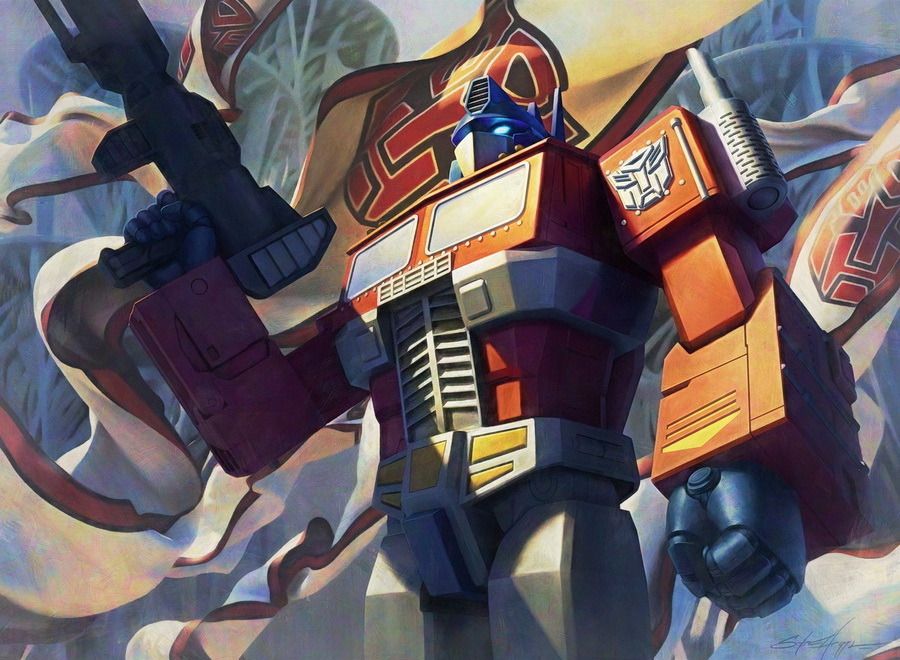
Optimus Prime, Inspiring Leader | Illustration by Steve Argyle
The basics of convert is that the front side of the card has information on it as to how you can “transform” it and flip it to the backside of the card. Likewise, the backside has information about how it can be transformed back to the front side.
For previous cards with transform this was typically tied with another mechanic (e.g., the day/night cycle) or past game state (e.g., the player during the last turn played no spells). For the Transformer cards this changes from card to card.
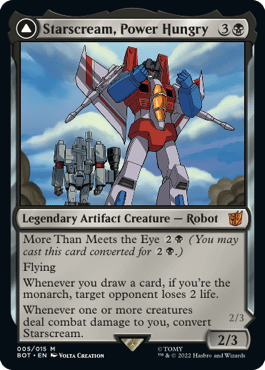

For example, Starscream, Power Hungry is converted to Starscream, Seeker Leader whenever one or more creatures deals combat damage to you. It converts back to the front side whenever you become the monarch (the card has a way to get the monarch chain started).
Why Not Just Use Transform?
I’m sure the question has already formed in your mind: why not just use transform? They’re Transformers, so they should just transform. The answer is copyright law.
For the entire lifetime of the Transformers franchise, the word for what they do is “convert” and not “transform.” This is to keep what they are and what they do separate as to not generalize the term for what “transformers” represent (e.g., Xerox being used for all photocopier machines/photocopied sheets).
This seems silly, but if the term becomes too generalized it would be possible for them to lose their copyright in court arguments as to how the public views the type of product versus the actual product itself. Basically if the holder of a trademark fails to police and enforce unauthorized use of their trademark, the holder risks genericide.
A real-world example of this is aspirin. Aspirin was a trademarked brand name by the Bayer company up until 1919 when the term became too generalized for acetylsalicylic acid and they lost their trademark in court. Your history lesson for the day.
Are Convert Cards Just Modal Double-Faced Cards?
No. Modal double-faced cards can be cast for either side of it with no side officially being the front or backside of the card, and each having their own distinct mana value. And once a MDFC has been played there’s no way to flip it while it’s still on the battlefield.
Are They Transforming Double-Faced Cards?
Convert is something most of us Magic players are already used to: transform. If you’ve played cards from any of the sets taking place in Innistrad (or at the very least Neon Dynasty in the case of its sagas), you’ll already be aware of this mechanic.
Convert and transform are functionally identical in Magic keyword terms at its essence. The rules of one are the rules of the other.
Is Convert a Triggered Ability?
Yes. When the game state or action meets the convert criteria, the card will convert. Just like other triggered abilities, the player may or may not get to decide on whether the effect occurs depending on the wording of the card.
What’s the Mana Value of a Converted Card?
The mana value of the card is whatever the mana value is on the front side of the card. Even if the card has its backside face up, the front side shares its mana value.
But in the case of copies of a converting card when the backside is face up, then the mana value is zero. This is because “double-faced” is a reference to the physical card which a copy or token cannot take from the original.
What if a Converted Card Dies? What Is It in the Graveyard?
Because each side of the card has their own name, type, subtype, abilities, etc., you only take the front side into consideration in any zone other than the battlefield. In the same vein, you only take whatever side of the card is face up when it’s on the battlefield. So if the artifact side of a converting card is face up and Damnation is played, the card wouldn’t be destroyed.
What if You Blink a Convert Card?
Unless the card specifically states otherwise, converting cards enter the battlefield with their front side face up. Blinking doesn’t constitute playing the card for its alternative casting cost in the case of the converting cards in Transformers.
Is Convert Good?
This is a tough question, partially because you’d have to ask the same of its identical twin transform, and also because it would really depend on the format you’re playing them in. Because these cards are only legal in Commander, Legacy, and Vintage (like all Universes Beyond cards), you can really only explore those.
In those terms I’d say yes, but your mileage may vary. Each of them are well-suited for the colors they represent, their criteria and conditions for converting make sense with their abilities and effects, and they present a cool level of flexibility. That doesn’t mean that they’ll replace any given card in any given deck, but you could say that for almost any card with multiple uses.
Gallery and List of Convert Cards
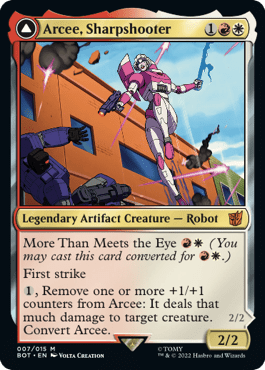
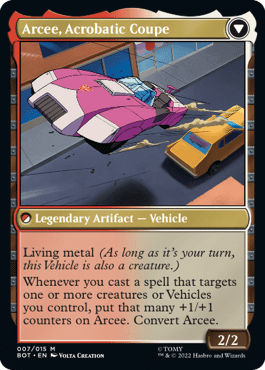
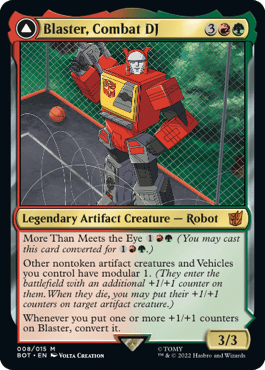


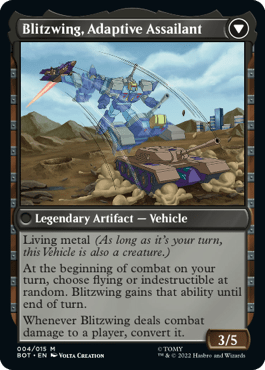


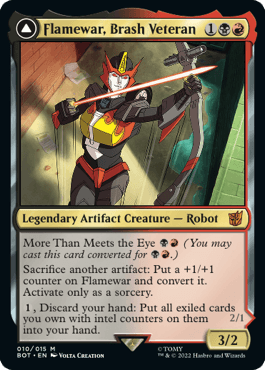
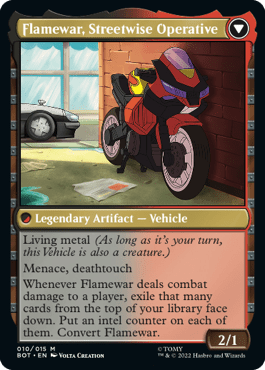
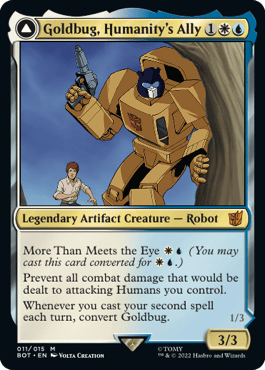
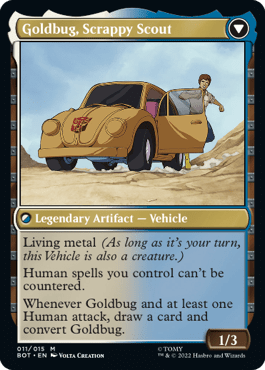
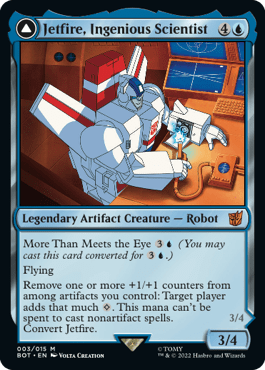
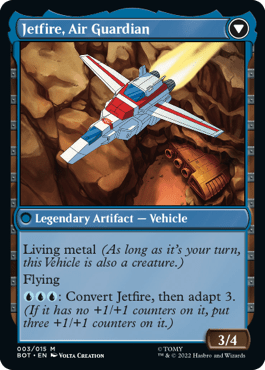

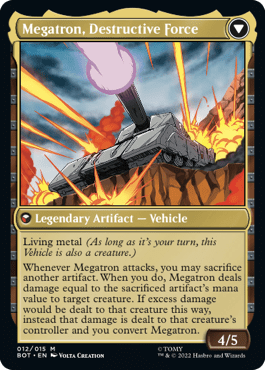



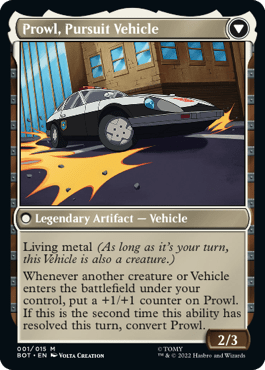
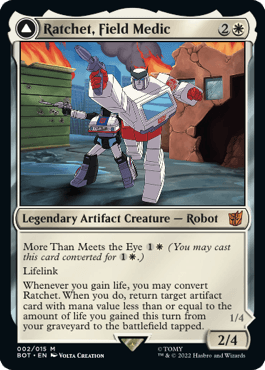
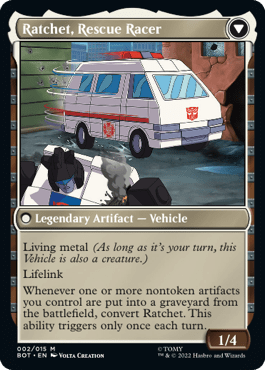


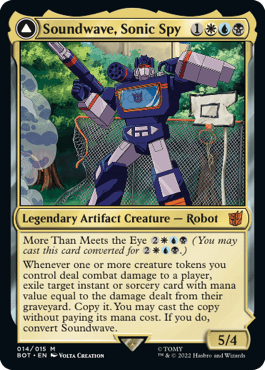
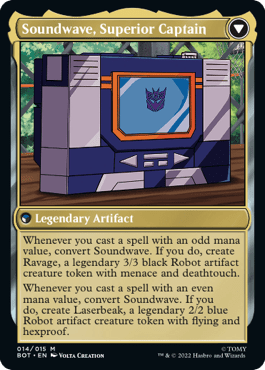



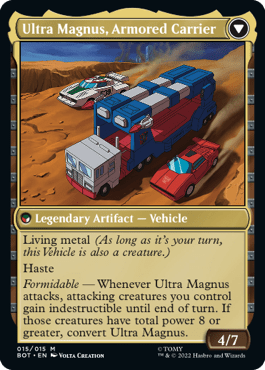
- Arcee, Sharpshooter / Arcee, Acrobatic Coupe
- Blaster, Combat DJ / Blaster, Morale Booster
- Blitzwing, Cruel Tormentor / Blitzwing, Adaptive Assailant
- Cyclonus, the Saboteur / Cyclonus, Cybertronian Fighter
- Flamewar, Brash Veteran / Flamewar, Streetwise Operative
- Goldbug, Humanity's Ally / Goldbug, Scrappy Scout
- Jetfire, Ingenious Scientist / Jetfire, Air Guardian
- Megatron, Tyrant / Megatron, Destructive Force
- Optimus Prime, Hero / Optimus Prime, Autobot Leader
- Prowl, Stoic Strategist / Prowl, Pursuit Vehicle
- Ratchet, Field Medic / Ratchet, Rescue Racer
- Slicer, Hired Muscle / Slicer, High-Speed Antagonist
- Soundwave, Sonic Spy / Soundwave, Superior Captain
- Starscream, Power Hungry / Starscream, Seeker Leader
- Ultra Magnus, Tactician / Ultra Magnus, Armored Carrier
Best Mechanic Cards
Universes Beyond cards are only legal in Commander, Legacy, and Vintage. I don’t personally play Legacy or Vintage so I can’t speak to these cards' usefulness in those formats. But I do play a fair bit of Commander.
I have these in no particular order, and they’d be the commanders for their decks.
Starscream, Power Hungry / Starscream, Seeker Leader


You’d be casting Starscream, Power Hungry for its more than meets the eye cost because the front side doesn’t do much without support from other cards or you play the backside first. But that side gets the monarch train going very easily with it having near perfect evasion (flying and menace) and haste to get in quickly.
What I like about this card is that it matches Starscream’s character perfectly. It also amps up the monarch mechanic and makes it asymmetric. I’ve been in a fair number of Commander games where the monarch gets involved but never means much more than an extra card draw. Weaponizing the monarchy for yourself is pretty cool and there shouldn’t be any shortage of ways to draw cards.
Ultra Magnus, Tactician / Ultra Magnus, Armored Carrier


Ultra Magnus, Tactician is a beefy card that likes to play beefy artifacts. While it’ll be mana hungry, it comes with some built-in protection and you’ll typically get your mana’s worth out of it with its ability to drop in artifact creatures from your hand.
My favorite bit though is that you’ll run a balance of wanting to maximize the power of your creatures with Ultra Magnus’s convert conditions so that your other creatures get indestructible and you can get more creatures out. Card draw to keep creatures in hand will be important, as will ways to control what you have out.
My perfect build for this would be a mix of haste enablers, extra combat steps, and a Mycosynth Lattice to make my big green stompies artifacts for it to grab.
Slicer, Hired Muscle / Slicer, High-Speed Antagonist


Aside for being monocolor, Slicer, Hired Muscle is a great goad commander. If you’re able to keep everything on the battlefield goaded then you actually won’t need much else to protect yourself until the later game.
I’d fill the deck with equipment, auras, and spells to protect Slicer, make it stronger when it’s attacking your opponents and harder to block. Honestly you could probably win some games with only having to take out whoever survives the melee 1v1.
Soundwave, Sonic Spy / Soundwave, Superior Captain


Soundwave, Sonic Spy is one of the best examples of how to helm a token deck. It not only has a way to create tokens (two you get a bit of a choice of, in fact), but it grants a bonus to you for when they attack. The bigger the army, the bigger the bonus.
Deckbuilding it would actually be fairly straightforward. Several cards like Shark Typhoon and Bitterblossom that create tokens repeatedly for you with anthems to bump them up and asymmetric board wipes to clear the field (multiple so you do it more than twice if you need to). While Soundwave’s colors aren’t great for tokens (I’d like some green), there are more than enough anthems and planeswalkers in those colors to boost them and assist in them getting through.
Optimus Prime, Hero / Optimus Prime, Autobot Leader


I love that they were able to roll Optimus Prime’s death arc into its abilities. Optimus Prime, Hero is a Boros () leader at heart with blue for the fun of it, and you’ll use that to its fullest potential.
Building around bolster can be a bit of a pain in small numbers, but with some recursion, targeted protection, and evasion, and a fully reusable bolster mule, you shouldn’t have much of a problem. I’m picturing Monoskelion, Spincrusher, Triskelion, Walking Ballista, and a Workhorse each soaking up the +1/+1 counters in turn as the other falls as ways to guarantee that Optimus not only gets to bolster them, but to convert to die another day.
Megatron, Tyrant / Megatron, Destructive Force


Living up to its role well, Megatron, Tyrant is suited to run both Starscream, with it contributing to lose of life, and Blitzwing, which also benefits from loss of life, in its deck.
As for the rest of the deck, you want to use Megatron’s ability to quickly convert back and forth as much as possible with artifacts that either have fairly high mana values, like Maelstrom Colossus and Darksteel Colossus, or ones that you benefit from having die, like Wurmcoil Engine and Triplicate Titan.
Sacrifice the artifacts to Megatron’s backside during combat and then convert it during the post-combat main phase to get some of the mana back to cast something else to take its place or put towards a spell like Wake the Past to get them all back again. Enchantments that automate the recursion, like Pia's Revolution, just speed up the process.
Wrap Up
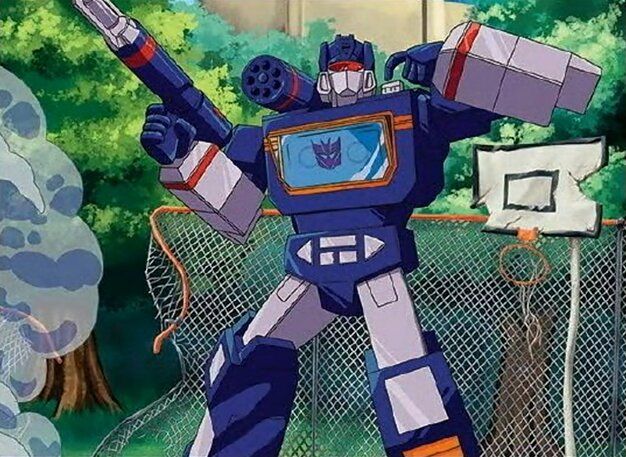
Soundwave, Sonic Spy | Illustration by Volta Creation
These seem to be the most fleshed out of the Universes Beyond products, which is good considering the breadth of their distribution and likelihood of players just getting one in a pack. I know that Dimir () has been interesting to debate and adopt in the community given the scarcity and price tag of the past examples, but hopefully these will see some play with them being cheaper and much more plentiful.
I feel like the convert/transform mechanic not only just feels right for these but has been designed very well to compliment that back-and-forth nature of these cards. As seen with Innistrad and its subsequent returns to the plane, there have been a number of doubles-sided cards that didn’t seem to have a lot of cards with abilities that flowed well into one another like these do. But with these I was immediately able to see how they work together and how I could build around to amplify their effects.
How do you feel about the “return” of convert? Do you think other mechanics should be given a new shake, or should they just stay in their lane? Let me know in our Discord, on Twitter, or in the comments below.
That’s all from me for now. Stay safe, stay healthy, and wash your hands!
Follow Draftsim for awesome articles and set updates: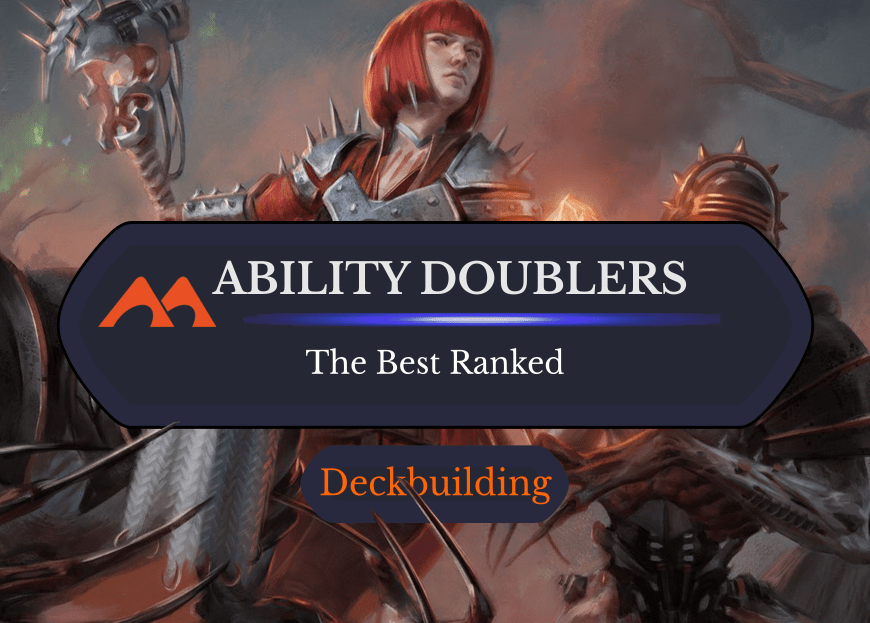
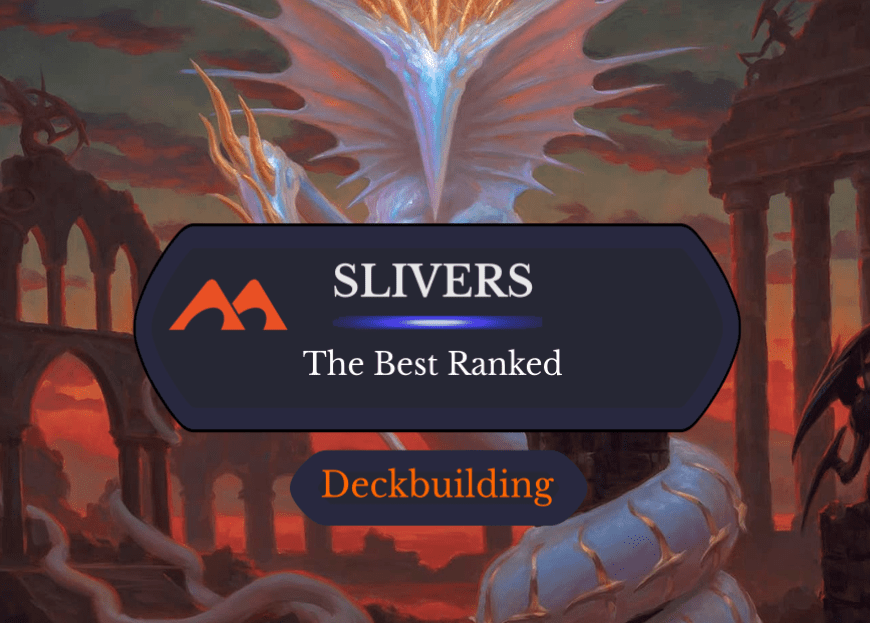
Add Comment